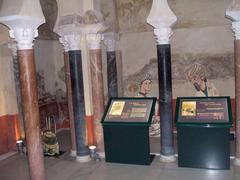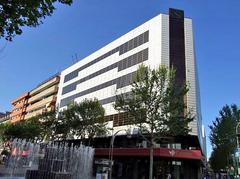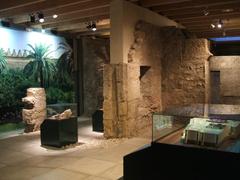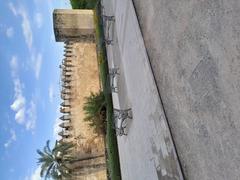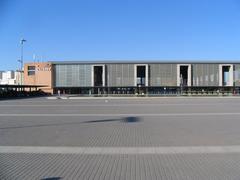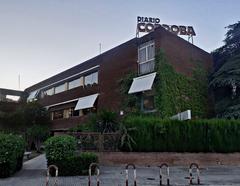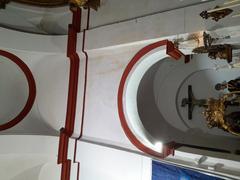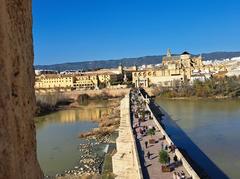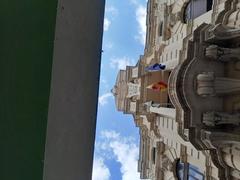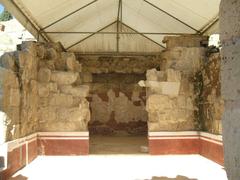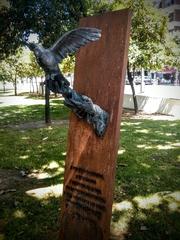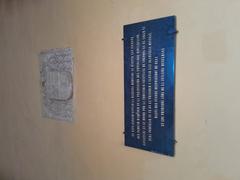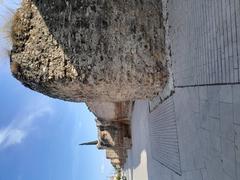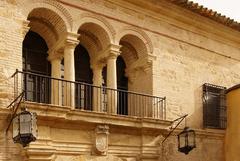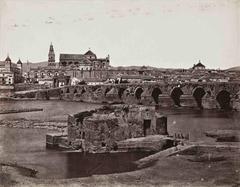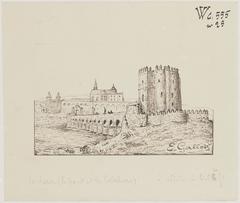Colegio Jerónimo Luís De Cabrera Córdoba Spain: Visiting Hours, Tickets, and Historical Sites Guide
Date: 14/06/2025
Introduction
Colegio Jerónimo Luís De Cabrera is a prominent landmark in Córdoba, Spain—a living symbol of the city’s educational progress, architectural innovation, and deep-rooted cultural identity. Established in the early 1960s during a period of significant urban and social transformation, the college was designed by the acclaimed architect Rafael de La-Hoz Arderius, reflecting the era’s modernist ideals while honoring the legacy of its namesake, Jerónimo Luis de Cabrera, the 16th-century conquistador and founder of Córdoba in Argentina. The institution’s distinctive design, its enduring role in the local community, and its proximity to key historical sites make it an essential destination for visitors interested in Andalusian modern architecture, urban history, and cultural traditions (docomomoiberico.com; arquitecturacontemporanea.org; infoescuelas.com).
This comprehensive guide offers detailed insights into the Colegio’s history, architectural significance, visitor information, and its relationship with nearby attractions, ensuring a rewarding and well-prepared visit.
Table of Contents
- Fundación y Contexto Histórico
- Arquitectura y Diseño Modernista
- Evolución y Significado Social
- Ubicación, Acceso y Horarios para Visitantes
- Consejos para Viajeros y Atracciones Cercanas
- Reconocimiento y Conservación Patrimonial
- Vida Escolar, Tradiciones y Eventos Especiales
- Preguntas Frecuentes (FAQ)
- Datos Relevantes y Actualidad
- Importancia para el Visitante
- Recursos Visuales y Enlaces Útiles
- Historical Context and Foundational Vision
- Architectural Style and Influences
- Key Architectural Features
- Urban Integration and Cultural Significance
- Practical Visitor Information
- Preservation and Visitor Experience
- Jerónimo Luis de Cabrera Monument: A Historical Landmark in Córdoba
- Plan Your Visit
Fundación y Contexto Histórico
El Colegio Jerónimo Luís de Cabrera fue fundado en los años 1962-1963 en el marco de la modernización educativa y arquitectónica de la España de posguerra. Su aparición responde a la necesidad de dotar a los nuevos barrios de Córdoba de infraestructuras educativas modernas. La denominación del colegio honra a Jerónimo Luis de Cabrera, conquistador y fundador de la Córdoba argentina, subrayando el vínculo cultural entre España y América Latina (docomomoiberico.com).
Arquitectura y Diseño Modernista
Diseñado por Rafael de La-Hoz Arderius, el colegio es un referente de la arquitectura escolar moderna andaluza. El edificio destaca por su funcionalidad, adaptación climática y el uso de la celosía en ventanas, elemento que protege del intenso sol cordobés y aporta identidad visual. La estructura se organiza en dos bandas de aulas separadas por un cuerpo central administrativo, y una vivienda de portería en la esquina del recinto. Actualmente, algunas celosías han sido reemplazadas por lamas orientables para mejorar el confort y la eficiencia energética (arquitecturacontemporanea.org).
Evolución y Significado Social
Desde su apertura, el colegio ha sido pilar educativo y social del barrio Sector Sur. Ha evolucionado de centro mixto (primaria e instituto) a CEIP (Educación Infantil y Primaria), adaptándose a la comunidad local. El modelo de gestión pública y el compromiso con la calidad educativa han consolidado su prestigio, promoviendo la integración y la cultura de paz (infoescuelas.com; buscocolegio.com).
Ubicación, Acceso y Horarios para Visitantes
Situado en Calle Adamuz 1 (CP 14013), Sector Sur de Córdoba, el colegio está próximo a puntos emblemáticos como el Puente Romano, el Alcázar de los Reyes Cristianos y la Torre de la Calahorra (mapcarta.com).
Horario de visitas: Lunes a viernes, de 9:00 a 14:00 y de 16:00 a 18:00 (horario escolar). Para visitas arquitectónicas o de grupo, contactar previamente.
Accesibilidad: Entrada y servicios adaptados a personas con movilidad reducida.
Entrada: Gratuita. No se requieren tickets, salvo para visitas guiadas concertadas.
Consejos para Viajeros y Atracciones Cercanas
Aproveche la visita al colegio para explorar el entorno histórico de Córdoba:
- Puente Romano: A 15 minutos a pie.
- Alcázar de los Reyes Cristianos: Palacio y jardines históricos.
- Torre de la Calahorra: Museo de la diversidad cultural cordobesa.
La zona cuenta con buena comunicación por autobús urbano y aparcamiento público. Las mejores épocas para visitar son primavera y otoño.
Reconocimiento y Conservación Patrimonial
El colegio está registrado en el Registro Andaluz de Arquitectura Contemporánea y ha sido objeto de estudios patrimoniales por su valor arquitectónico. Su clasificación como equipamiento de “Nivel B” asegura la protección y preservación de sus elementos originales (docomomoiberico.com; arquitecturacontemporanea.org).
Vida Escolar, Tradiciones y Eventos Especiales
La comunidad educativa participa activamente en eventos como el Día de Andalucía, combinando innovación pedagógica y tradiciones culturales (ceipjeronimoluisdecabrera). El colegio incorpora nuevas tecnologías y métodos educativos, manteniendo su legado histórico.
Preguntas Frecuentes (FAQ)
- ¿Se puede visitar el colegio? Sí, con solicitud previa para visitas guiadas.
- ¿La entrada es gratuita? Sí.
- ¿Es accesible para personas con movilidad reducida? Sí.
- ¿Hay eventos especiales para visitantes? Principalmente escolares, algunos abiertos al público.
- ¿Cómo llegar desde el centro? En autobús, taxi o a pie (20 minutos aprox.).
Datos Relevantes y Actualidad
- Fundación: 1962-1963
- Arquitecto: Rafael de La-Hoz Arderius
- Dirección: Calle Adamuz 1, 14013, Córdoba
- Tipo: Público, Infantil y Primaria
- Teléfono: 957734593
- Modelo educativo: Cultura de paz e integración (infoescuelas.com)
El colegio goza de excelente valoración en la comunidad, con puntuación media de 4.7/5 en plataformas educativas (micole.net).
Importancia para el Visitante
El colegio es ejemplo de evolución urbana, cultural y educativa en Córdoba. Su visita complementa el recorrido por otros hitos históricos de la ciudad y permite conocer de cerca la arquitectura moderna andaluza (docomomoiberico.com).
Recursos Visuales y Enlaces Útiles
- Recorrido virtual y fotografías
- Mapa interactivo de Córdoba
- Sitio oficial del CEIP Jerónimo Luís de Cabrera
- Información turística municipal
Historical Context and Foundational Vision
Colegio Jerónimo Luís De Cabrera’s architectural significance also draws from Córdoba’s colonial roots and the urban planning principles of the Spanish Empire. Inspired by the Laws of the Indies and Jesuit educational tradition, its location and design embody a blend of colonial, neoclassical, and modernist influences (aprende-historia.com; worldcityhistory.com).
Architectural Style and Influences
Colonial and Jesuit Heritage
The Colegio’s design reflects Córdoba’s colonial and Jesuit heritage: arcaded corridors, robust masonry, and integrated courtyards foster communal learning and climate adaptation (lacgeo.com). The proximity to the Jesuit Block and use of restrained ornamentation echo the city’s UNESCO-listed educational precincts.
Neoclassical and Modernist Adaptations
Later renovations incorporated neoclassical elements and modernist forms, introducing open, functional spaces and streamlined facades to accommodate contemporary pedagogic and accessibility needs.
Key Architectural Features
- Central Courtyard (Patio): Arcaded walkways and stone columns create a communal heart for the school.
- Facade and Entryway: A blend of colonial solidity and neoclassical refinement, with wrought-iron balconies and carved doors.
- Chapel and Religious Spaces: Houses baroque altarpieces and hosts cultural events (aprende-historia.com).
- Adaptive Reuse: Modern facilities and technological upgrades ensure continued relevance.
Urban Integration and Cultural Significance
The Colegio’s integration into Córdoba’s urban core, near the main plaza and other historic sites, highlights its enduring civic and educational role (worldcityhistory.com). Its spaces host academic, cultural, and civic events, reinforcing Córdoba’s identity as “La Docta”.
Practical Visitor Information
Visiting Hours and Tickets
- General visiting hours: Monday–Friday, 9:00–14:00 and 16:00–18:00 (school term); weekends or special events by arrangement.
- Entry: Free. Guided tours or special events may require advance reservation and a small fee.
Accessibility and Facilities
- Fully accessible for visitors with disabilities.
- Restrooms and seating areas available.
- Audio guides and multilingual tours offered during special events.
Guided Tours and Special Events
- Daily guided tours (by request) offer insights into architecture and history.
- Schedule in advance via official channels or local tourism offices.
Travel Tips and Nearby Attractions
- Walk or use public transport to reach key sites: Jesuit Block, Córdoba Cathedral, Roman Bridge.
- Wear comfortable shoes, bring water, and allocate at least 2 hours for your visit.
Photography
- Permitted in most areas; seek permission for interior shots or during school hours.
Preservation and Visitor Experience
Ongoing conservation supports the Colegio’s heritage status (aprende-historia.com). Interpretive panels and guided experiences explain the site’s evolution and importance, while its inclusion in city walking tours invites visitors to connect with Córdoba’s broader cultural landscape (lacgeo.com).
Jerónimo Luis de Cabrera Monument: A Historical Landmark in Córdoba
Introduction & Significance
Located in Córdoba, Argentina, this monument honors the city’s founder and stands as a focal point for heritage, public gatherings, and educational tours.
Visiting Information
- Location: City center, accessible by public transport.
- Access: 24 hours (public square); guided tours 9:00–18:00.
- Entry: Free; guided tours may require booking.
Tips
- Visit in spring or fall for ideal weather.
- Explore nearby: Cathedral, Plaza San Martín, Museum of Contemporary Art.
Events
Cultural and historical events are regularly held at the monument; guided tours are available in multiple languages.
Plan Your Visit
Plan ahead by contacting the Colegio for visiting hours and guided tour availability. Use public transport for convenience and respect the cultural environment. Download the Audiala app for interactive guides and real-time updates, and follow Córdoba’s tourism channels for news on events and exhibitions.
For local transit, see the Moovit public transit guide. For background on Jerónimo Luis de Cabrera’s legacy, explore Viapais’s article.
Summary and Final Tips
Colegio Jerónimo Luís De Cabrera is a vital part of Córdoba’s architectural and social fabric, offering free access, guided tours, and a unique blend of modern and historical influences. Its proximity to major heritage sites makes it a must-see for cultural tourists and architecture enthusiasts. Ensure a fulfilling visit by coordinating in advance, respecting school protocols, and integrating your trip with other significant Córdoba landmarks (turismodecordoba.org; docomomoiberico.com).
References and Further Reading
- docomomoiberico.com
- arquitecturacontemporanea.org
- infoescuelas.com
- Moovit public transit guide
- aprende-historia.com
- turismodecordoba.org
- buscocolegio.com
- micole.net
- Viapais - Jerónimo Luis de Cabrera
- lacgeo.com
- worldcityhistory.com
